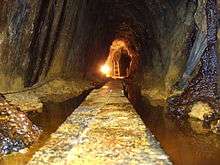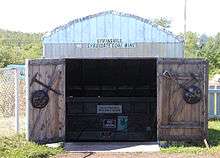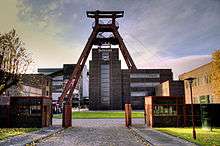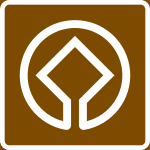Mining tourism
This is a travel topic that deals with all man-made structures under and above ground whose primary purpose is or was the extraction of natural resources as well as their remains, associated culture and small scale resource gathering such as gold panning from rivers and creeks.
Understand

| “ | I was born one mornin' when the sun didn't shine I picked up my shovel and I walked to the mine I loaded sixteen tons of number nine coal And the straw boss said "Well, a-bless my soul" |
” |
—Merle Travis | ||
Humans have dug more or less elaborate holes in the ground in order to extract resources since time immemorial. The oldest things archaeologists interpret as mines were found in modern day Egypt and were used to extract flint-stone some 30,000 years ago. Since then both the need for resources and the technology with which to extract them have experienced tremendous development. Modern-day open pit mines have transformed whole landscapes and once they are done removing all the desirable resources, they often leave man made lakes and ponds that can become a source of economic activity and tourism in themselves. While some active mines can be visited, most mines are closed to the general public with only a small visitor center if anything. However, some former mines have been converted into tourist attractions and you can learn a lot about the history of the region or of mining in general by taking a guided tour.
Some towns owe their existence or at least their current size to mining, be it Kiruna and Falun in Sweden, Norilsk in Russia or continued human presence on Svalbard. On the other hand, many former mining communities have been deserted once resources run out, and bustling cities can become ghost towns overnight. In some cases a mine itself is the reason for the abandonment of settlements, either to make room for open-pit mining or due to environmental damage through mining.
Mining has also added its own rich character to the cultural heritage of many regions, from the vocal imagery of the powerful folk ballad to the literary works recording old miners' myths.
Mining and the associated culture - especially in the context of coal and steel - have also influenced things as seemingly unrelated or trivial as the names or nicknames of sports teams. Many areas - especially in high-income countries - that used to depend on mining have since entered a decline, and despite efforts to diversify the economy, many of those areas have become "rust belts". That said, people are often immensely proud of the mining heritage of their region and some even continue to live those traditions after having moved elsewhere for a job.
Open pit versus shafts and tunnels
Modern mining often involves open pits created by huge machines. Older mines dug by hand often involve deep shafts and adits (long narrow corridors) underground. For instance the silver mines at Kongsberg has the deepest point 1,000 m below the surface (several hundred meters below sea level). The intensive 1600s mining at Falun eventually resulted in a collapse of the underground sections, leaving a 100-m deep and 1-km wide crater. A major problem in (almost) all mining operations is water. In open pit mines groundwater has to be lowered, sometimes hundreds of meters, leading to ground movements that are still not entirely understood and that have in the past damaged houses and other structures several km away from the mine. Once the mining is concluded the rising groundwater also results in ground movements, which may further endanger property. In underground mines, water has to be pumped out and of course this water has to go somewhere. In some cases it is simply pumped into abandoned shafts, but elsewhere ponds have been created just from surplus mine water.
Salt mining
Salt was a valuable commodity for most of history and scarce in almost all inland regions. The very word "salary" is derived from the Latin word for salt. While sea salt played a role in some areas, it was then as it is now vastly overshadowed by mined salt. While the people in the North Frisian Islands burned the ground beneath their feet to access the salt contained in the peat, other regions had access to vast underground salt domes, which gave rise to fabulous wealth and to names often relating to former or current salt production, such as Bad Reichenhall with "hall" being a frequent component in city names in Central Europe related to salt mining.
Mothballed rock salt mines are considered among the safest options to get rid of radioactive waste through deep geological disposal of such materials. The crystalline salt is an excellent thermal conductor to keep the waste cool, and naturally seals cavities to prevent leakage of active materials into ground water. It is expected that at least some mines currently open to the public will be converted for such waste disposal purposes in the near future, making them inaccessible to mankind for the next 50,000 years. If you have an interest in visiting decommissioned salt mines, do it as soon as you can.
See
Australia
Every state of Australia has a mining history, and in most states there are former mining sites that are considered vital heritage locations, and current active locations that have facilities for visitors and tourists to visit and view.
South Australia
- 🌍 Coober Pedy. An opal-mining town in the South Australian Outback that is almost fully underground, as this is the only way to ensure human habitation in the harsh climate.
Western Australia
- 🌍 Kalgoorlie Super Pit, Fimiston, West Australia. The Kalgoorlie Super Pit in Western Australia is a vast open pit that is visitable by guided tours.
Bolivia
Canada

- 🌍 Springhill Miners' Museum, 145 Black River Rd, ☎ +1 902-597-3449. Springhill, Nova Scotia, was the site of a large coal mine active from the 19th century until 1958. It was shut down after an explosion in 1956 killed 39 and a 'bump' (underground earthquake) in 1958 killed 75. Today the museum offers underground tours. There is a song The Ballad of Springhill, about the 1958 disaster, which has been recorded or performed by many artists including Peter, Paul & Mary, U2, and husband/wife duo Ewen MacColl and Peggy Seeger.
- 🌍 Cape Breton Miners Museum, 17 Museum St, Glace Bay, Cape Breton, ☎ +1 902-849-4522. 10AM-6PM (end-May to Thanksgiving). Underground mine tour, mining history museum (C$6/person) with modern exhibits. Miners Village Restaurant. Stroll through a historic village. "Men of the Deeps" miners' choir offers performances ($13/person) several times per season. C$15/person.
- 🌍 Frank Slide Interpretive Centre, Hwy 3 Crowsnest Pass, Blairmore, ☎ +1 403-562-7388. The small coal-mining town of Frank in the Crowsnest Pass region of what is now Alberta had 82 million metric tons of rock come crashing down on it in 1903. Turtle Mountain, above the town, had unstable geology to begin with and had been made more unstable by extensive mining. This was Canada's deadliest rockslide ever, killing 90, but fortunately it missed much of the town.
Estonia
- 🌍 East Estonia. The region lies at the heart of Estonia's century-old oil shale mining, which is commemorated by a number of local museums. Some of the highest hills in the otherwise flat region are man-made "ash mountains"—huge piles of oil shale industry waste—that have been forested and put to recreational use.
Finland
- 🌍 Tytyri Mining Museum, ☎ +358 44 369 1309. The calcite mine in Tytyri near Lohja is also open to visitors by guided tour (other languages than Finnish must be pre-booked). Minibuses take visitors 100 m underground where also a museum exhibiting the history of the mine is located. adults €14, children €8.
France
- 🌍 Mining Center of Faymoreau (Centre Minier de Faymoreau), Faymoreau, Rue la Cour, ☎ +33 2 51 00 48 48.
Germany

- 🌍 Precious Stone Mine Steinkaulenberg (Edelsteinminen Steinkaulenberg), Idar-Oberstein, Tiefensteiner Str. 87, ☎ +49 6781 901918.
- 🌍 Himmelfahrt show mine (Himmelfahrt Fundgrube, Besucherbergwerk Freiberg), Freiberg, Fuchsmühlenweg 9, ☎ +49 3731 394571. 300-year old silver mine, used to demonstrate the history of mining during different eras. There are different tours, from 45 minutes to 5 hours, illustrating geology, history and technology of eight centuries. The entire town of Freiberg has a long and storied history of mining (though since the fall of the GDR no active mining anywhere in the vicinity) and is also home to the second oldest technical university in the world, mostly dedicated to geology, mining and related sciences Tours €13–40 (reduced €6–35).
- The whole Ruhr area was associated with coal mining and heavy industry for over a century. While most pits and cokeries are closed by now, you can still see impressive remains like the UNESCO world heritage Zeche Zollverein in Essen, as well as creatively re-used former mining and industrial sites that were transformed into parks, exhibition halls event locations or an amphitheatre. See also Industrial Heritage Trail.
- Lüneburg owes much of its former wealth (still seen in old buildings) to its long history of salt mining; giving one of the resources needed for the Hanseatic cities to become major exporters of preserved fish.
Nauru
Norway
- 🌍 White Caves (Kvite grotter), Gudvangen (Road E6). Abandoned mines open to public during summer. The white stone is anorthosite and exists in greater quantity at Gudvangen than anywhere else. Fee.
- 🌍 Silvermines at Kongsberg (Sølvgruvene på Kongsberg), Kongsberg. A train brings the visitors 2300 m in. More than 300 years of silver mining has left a web of some 1000 km of tunnels, and 300 shafts of which the deepest is 1000 m. The mines cover an area of 30 km². More than 1 million kilograms of pure silver were extracted. Fee.
- 🌍
Røros mining town (Røros by og kopperverk), Røros, Trøndelag. The Røros copper mines were in operation for 333 years. Røros was one of two privileged mining towns (Kongsberg the other). Røros retain the style from the time when it was developed. The unusual church dominates the skyline. The town and mines are a UNESCO world heritage site.

- Limestone mines at Eide, Eide near Molde. Abandoned limestone/marble mines can be visited by groups. A wide hall with stage and seating. Access by boat across small pond. The temperature is a constant 6°C.
- 🌍 Cobalt color mines (Blaafarveverket i Modum), Drammen, Buskerud county. Blaafarveværke began operations in the 1770s. The works mined cobalt ore and manufactured blue cobalt glass (smalt) and cobalt blue (cobalt aluminate) pigment. In its heyday, it supplied 80 percent of the world market for cobalt pigments. Open for visitors. Buildings are also used for art exhibitions. Fee: Yes.
Pakistan
- 🌍 Khewra Salt Mine, Khewra, ☎ +92 544 231137. The discovery of the world's second largest salt mine dates back to the time of Alexander the Great's Indian Campaign of the 4th century BC, although the current tunnel was started in 1872 during the British rule of the subcontinent. The mine is a large tourist attraction, with several constructions made of colourfully illuminated salt bricks inside, and is the only source of the pinkish "Himalayan salt", which is almost fetishistically sought after by whole food enthusiasts.
Poland
- 🌍 Wieliczka Salt Mine, Daniłowicza 10, Wieliczka, ☎ +48 12 278-73-02. Continuously in production between the 13th century and 2007, which makes it one of the oldest enterprises in the world that until recently was still in operation, this mine is famous for its many statues and chapels carved out of rock salt by the miners.
South Africa
- 🌍 Kimberley Mine, S Circular Rd, Kimberley, ☎ +27 53 839 4600. A former open-pit and underground diamond mine, operating from 1871-1914. The open pit, also known as the Big Hole, is notable for being the largest hole in the ground excavated without machinery. There's a museum on site as well.
Sweden
- Bergslagen, northern Svealand, Sweden. This region north of Lake Mälaren is the historical heartland of Swedish mining, metallurgy and industry. It was once one of the most productive mining areas in Europe, but has now declined into a single mine. However, a lot of mining heritage remains open for visitors.
- 🌍
Falu Gruva (Falun Mine), Falun, Dalarna. The Falun copper mine operated for around 1000 years until 1992. It was for centuries the largest copper mine in Europe and supplied about 70% of all copper need in Europe. Several thousand shafts were dug. The mining company is possibly the oldest business enterprise in the world. Now museum open to the public. The mines and the town are a UNESCO world heritage site.

- 🌍
Falu Gruva (Falun Mine), Falun, Dalarna. The Falun copper mine operated for around 1000 years until 1992. It was for centuries the largest copper mine in Europe and supplied about 70% of all copper need in Europe. Several thousand shafts were dug. The mining company is possibly the oldest business enterprise in the world. Now museum open to the public. The mines and the town are a UNESCO world heritage site.
- 🌍 Kiruna mine, Kiruna (The tours starts at the main square at the tourist information centre.). Almost 3 hour guided tour to the iron mine takes you to the mininge company's (LKAB) visitor centre located at 540 metres underground. The history, as well as ongoing mining operations and Kiruna town moving due to the mine subsidence, effecting large parts of the city, is discussed. The tour can be booked in the information centre or online. 360 SEK (adult), 260 SEK (student/senior), 60 SEK (child; 1 child, 6-15 years, for free per paying adult)..
United Kingdom
- See also: Industrial Britain
- 🌍 Grime's Graves, Lynford, Weeting, Thetford IP26 5DE (near Barton, Suffolk), ☎ +44 370 333-1181. Prehistoric flint mine, extensive neolithic flint extraction.
- 🌍 National Mining Museum for England, New Road, Wakefield (England) WF4 4RH, ☎ +44 1924 848806. Daily 10AM–5PM. Few of us nowadays will ever go underground in a working coal mine, so this museum (the former Caphouse Colliery) is an essential experience of this great but departed industry. Free.
- 🌍 Poldark Mine, Trenear, Wendron, Helston, Cornwall TR13 0ES (two miles North of Helston on the B3297 Helston to Redruth road), ☎ +44 1326 573 173, e-mail: info@poldarkmine.org.uk. Guided tour through ancient tin mine workings, museum of mining equipment and craft workshops. Located within the Wendron Mining District of the Cornwall and West Devon Mining Landscape World Heritage Site. £18.50/adult.
- 🌍 Wheal Martyn Museum.
- 🌍 LLechwed Slate Caverns, A470, Blaenau Ffestiniog LL41 3NB, ☎ +44 1766 830306. Ancient rock quarry, a museum and underground tour gives a view of the North Wales slate industry. Workshops, history exhibits.
- 🌍 Dolaucothi Gold Mines, Pumsaint, Llanwrda, Carmarthenshire, SA19 8US (on A482), e-mail: dolaucothi@nationaltrust.org.uk. A wooded hillside, leading to the entrance of gold mines that were in use from the Roman period, up until the early 20th century. Guided tours. Phone before arrival to confirm opening times.
- 🌍 Big Pit National Coal Museum, Blaenafon, Torfaen NP4 9XP, ☎ +44 29 2057-3650, fax: +44 29 2057-3668, e-mail: bigpit@museumwales.ac.uk. A former colliery site with extensive surface buildings; a 90-min guided tour goes underground to what was a literal 'coalface' of an entire energy industry, Stout footwear recommended. 0300 111 2 333 (local-rate within UK)
- 🌍 Silver Mountain Experience, Llywernog, Ponterwyd, Aberystwyth, Ceredigion SY23 3AB, ☎ +44 1970 890-620. Mining museum in restored Victorian-era silver mine buildings, 45-minute guided tours of the mine and trail. Café and souvenir shop; special events seasonally.
United States
- The Industrialization of the United States was built on coal and steel. Most of what is now the "rust belt" was active in mining coal and the various ores needed to transform an agrarian backwater into the leading industrial power of the world. Some mines and related industries are on the American Industry Tour.
- Similarly, many of the ghost towns of the American West were boomtowns that sprung up around gold and silver strikes, only to dwindle away once the mines were worked out.
Do
One of the more obvious things often offered to tourists is gold panning, especially in areas where it has a tradition, like those invoking the Old West of the U.S.
The gold is by no means gone from the rivers and creeks of this world. While some people actually believe to be able to make a living by gold panning, chances are that the gold you find (if any) while panning in any river is not enough to pay for a first world lifestyle. However, gold panning is still practised in low income countries as an additional or only source of income.
At some destinations, a private company will maintain an active claim on a river where there's a little gold left so that visitors may try their hand at gold panning.
- 🌍 Chicken, Alaska, USA. This tiny village mined 55,000 ounces (1710 kg) of gold from 1959-1971; it is now an off-the-grid partial ghost town with three operating businesses, a small post office and an airstrip. There is a seasonal gravel road. The old Pedro Gold Dredge #4 is open for daily tours and a couple of vendors offer recreational gold panning.
Talk
In many areas that have a long mining tradition a whole range of mining related terms have been coined and in some cases entered the general vocabulary. They can be confusing even to native speakers of the respective languages.
Stay safe
Before modern times, miners commonly died in accidents, if not from unhealthy conditions. Even today, mining is a hazardous industry.
If you are on a guided tour at a mining site, stay with the tour. Don't drift away or get diverted. If the tour is accredited and official, miners have specific guidelines of what not to do. Take careful note, and follow the rules.
Old, abandoned and unmaintained mine workings inherently pose more risk than those that are in active use. Exploring these as a lone traveller is advised against in very strong terms, consider joining an appropriate specialist group instead. The small number of enthusiast and research groups that exist have built up appropriate procedures expertise and trust with site owners over many years. Even when precautions are taken, those expeditions inherently pose some danger and thus people get stuck or injured in far reaches of underground structures, making it all the more imperative to have others know about your precise plans and whereabouts.
See also
- Ghost towns#Gold rush towns and abandoned mining communities. Many ghost towns used to be mining communities; a few were abandoned due to environmental disaster or after losing a road or rail line; many more were simply deserted after too little ore remained to be profitable.
- Industrial tourism — many mining regions are also places to see former or modern day industrial plants processing the extracted resources.